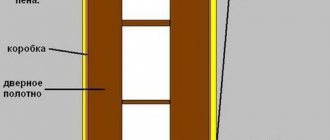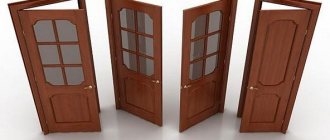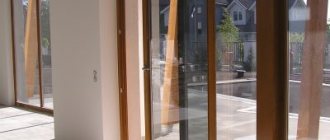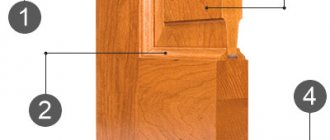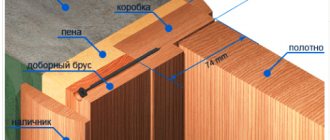To see how automatic doors work, just take a walk to the nearest shopping center, train station or airport. Sliding systems that react to the approach of a person have long lost their status as a curiosity. Along with its widespread use in facilities with high throughput requirements, automation is being introduced into everyday life, where it increases the comfort of apartments and becomes a useful addition to smart home equipment.
- How do interior automatic doors work?
- Advantages
- Automation operating principle
- Necessity
- Types of electric drives by operating principle
- Sensors for automatic opening/closing
- What you need to create smart doors
- How to install automatic doors yourself
- Operating instructions
- Advantages and disadvantages
- Common problems with automatic doors at home
How do interior automatic doors work?
Automatic interior doors are installed in the regular place of ordinary ones. In addition to the standard opening, the device can be located in a separate wall cassette, dividing the room in two. The standard kit consists of:
- movable flap or flaps;
- base profile-rail;
- drive device (geared motor, toothed belt, pulleys, etc.);
- electronics unit (controller);
- IR sensor.
Depending on the desired functionality, the automation is supplemented with a security system, electronic lock, manual opening unit, remote control and other equally useful accessories.
In the manufacture of sliding systems, rigid aluminum profiles and tempered glass are used.
Automatic opening of doors in single-leaf versions is carried out in one direction. Bi-leaf systems involve the divergence of the valves to the sides from the center.
Advantages
Unlike conventional devices, they do not remain open due to the forgetfulness of the owners. The automatically controlled sliding system eliminates the negligence inherent in humans. Therefore, the device has a long service life.
Despite their apparent fragility, modern automatic sliding structures are highly reliable and safe, which is achieved by using high-quality elements, materials and timely prevention.
Automation operating principle
Automatically opening door systems operate on the principle of moving the leaves along the profile using an electric drive device. The mechanics are complemented by a sensitive infrared sensor that monitors the surrounding area. Reacting to the approach of a person, the motion sensor sends a signal to the controller, which converts it into the appropriate command. The doors are automatically closed after the zone controlled by the sensor is released after a period of time determined by the delay time.
Necessity
The need for automatic interior doors is a controversial issue. Most people find them too chic, for which they have to pay a lot of money. On the other hand, an automated system eliminates the age-old problem of doors being opened due to forgetfulness. Automation brings comfort, eliminates drafts and heat loss, and allows you not to worry about the passage of pets. Devices included in the smart home system increase the level of security and allow you to control movement around the premises.
Features of choice - what does the driver need to know?
When purchasing a lock, you should consider how exactly it will be controlled. If it will only be used for opening using a button from the interior, then a standard one will do - its installation is quite easy to do yourself. In order for an electric lock to be activated from the alarm remote control, a more complex electrical mechanism is needed, the connection of which should only be entrusted to an experienced electrician.
Several models of electric locks are sold on the domestic market. By type, they are standard with side fastenings and reinforced (a little more expensive) - they are made of higher quality and are more reliable in use. When purchasing an electric lid drive, it is best to choose a kit with an inertia mechanism. This mechanism does not allow the engine to experience a constant load - if its rod rests against something, it turns off.
The principle of operation of the inertial mechanism is that when the button is pressed, such a mechanism first unwinds, increasing its traction force, and transmits it further to the pushing rod. At this time, a drive with a conventional motor type continues to operate while under load - it can quickly fail due to overheating.
Types of electric drives by operating principle
Among the designs on the market, the most widespread are the following automatic door systems:
- Classic. One roller guide is used to move the blades. The approach to the adjacent area is accompanied by the launch of a gear motor, which sets the doors in motion. Classic models are represented by one-, two- and three-leaf designs.
- Telescopic. Designed for wide aisles. Includes several independent sashes. Provide high opening/closing speed.
- Folding . Unlike other types of sliding systems, the panels do not go to the side, but are folded like an accordion or rolled onto a drum. The design is relevant for rooms with limited space when a wide passage is necessary.
Did you know that...
Some actuators begin to close the door when a person pulls the tailgate down slightly, indicating a desire to close it. Remember a computer CD-ROM: give it a little push and the tray slides away on its own.
The device allows you to implement an interesting function - the door is raised not to its full height, but by an amount programmed by the driver. This may be required in a garage with a low ceiling. The Hall sensor allows the “electronic intelligence” to count the number of revolutions of the electric motor that are necessary to lift the door to a given height. You can set the door lift height by pressing a button on the remote control or on the door itself.
Ways to control the door drive: 1 - button on the instrument panel; 2 — button on the door outside; 3 — button on the end of the door; 4 — button on the key fob.
Ways to control the door drive: 1 - button on the instrument panel; 2 — button on the door outside; 3 — button on the end of the door; 4 — button on the key fob.
Sensors for automatic opening/closing
A mandatory element of automated opening/closing systems is an infrared motion sensor. The compact device is located above the entrance and monitors the surrounding area. The sensor is equipped with settings for sensitivity and field of view.
A slip sensor, combined with an electric drive, quickly opens the doors if an obstacle appears in their path. An optical photo sensor serves the same purpose, preventing accidents.
Ventilation grates
Fire doors can be equipped with ventilation grilles. Grilles are made of stainless steel and are installed, as a rule, to ensure free circulation of air inside.
Grids can be of the following types:
- Regular or “Through-through” - when installing such a grille, the fire door loses its smoke and gas tightness and loses its soundproofing properties;
- Special “Self-closing” grilles – these ventilation grilles consist of several parts. One of them is stationary; it is the one that provides the necessary air circulation inside the room. The other part is movable with a thermosetting seal.
The mechanism of operation of the “Self-Closing” ventilation grille is simple - in the open position it works just like a regular “through” grille.
However, when the air in the room is heated to a certain critical level (for example, 75 degrees Celsius), the moving part with the seal in the grille closes on its own, and the grille becomes smoke-tight.
This happens because there are special springs in the grille that hold the open part of the grille. They, in turn, are restrained by a special fusible element - it melts at the moment when the temperature rises to a critical level and releases the springs, which close the hole.
Such ventilation grilles do not have soundproofing properties, but they contain hot smoke in the event of a fire.
At the same time, they can let cold smoke through, so doors with such grilles cannot be called smoke-gas-tight, because this term implies protection from both hot and cold smoke, as well as protection from harmful gases generated when materials burn.
What you need to create smart doors
Before installing automatic interior doors, you need to measure and prepare the opening. Smooth, silent running is achieved by carefully leveling the walls and floors at the points where the elements are attached. Then they start assembling. Ideally, the system is presented as a single set. In order to save money, ready-made elements from different manufacturers are used or made independently. The layout includes electrical wiring, determination of locations for sensors and additional accessories.
Content
- Installation of automatic sliding doors Security
- Standard Equipment
- Comfort, safety and efficiency
The Glass Stroy company produces and installs sliding all-glass automatic doors using operators from Dorma and other manufacturers.
Order a free estimate
Call a surveyor
Operating instructions
In the standard version, the devices are equipped with a five or six-position switch that sets the required modes:
- Full opening.
- Adjustable passage width.
- One-way control (input or output).
- Open state.
- Closed state
The operating rules for automatic sliding systems imply strict adherence to safety measures. When crossing the door area, it is prohibited to stop, run or interfere with moving doors. Passage is carried out with the doors completely open. Children's games are not allowed in the area of working doors.
A guarantee of uninterrupted operation of the system is periodic maintenance, expressed in cleaning the sensors, lubricating the mechanisms, as well as running the device in self-test mode.
Advantages and disadvantages
Compared to conventional swing doors, automatic sliding systems have a number of undeniable advantages. The advantages are presented in table No. 1.
| Automatic sliding | Simple swing |
| Comfortable and safe. Provide several operating modes. | Unpretentious in operation and maintenance. |
| Reliable and durable. Automation eliminates careless handling. | Does not require power supply. |
| Economical. Minimizes heat loss. | |
| Versatile. Provide passage of the required width. | |
| Compatible with monitoring and security systems. Equipped with video surveillance, remote control, electronic locks, etc. |
Tab. No. 1
Automatically opening and closing sliding doors save space. However, comfort comes at a price. The main disadvantage of the systems is their high cost. The devices require labor-intensive maintenance. Dependence on electricity makes them useless in the event of a lack of power or forces them to acquire autonomous sources. Malfunctions and breakdowns of automatic doors result in large costs.
Common problems with automatic doors at home
Modern automatic systems for opening and closing doors do not have the low reliability that was noted in the first models. However, complex devices are not protected from malfunctions, which are expressed in the following options:
- The electric drive for the interior door does not work. The power supply and mode are checked. It is necessary to make sure that there are no blockages or obstacles in the path of movement of the shutters, restart and test the electric drive.
- After movement, the door remains open. If there is no interference between the leaves, the IR motion sensor, the light barrier and the presence of power supply are checked.
- The door opens on one side. Opposite motion sensor malfunction.
- The system does not react to approach; it independently controls the movement of the shutters . If there is no interference in the form of radiation activating the approach sensor, the electric drive must be restarted. Otherwise, the controller may malfunction.
- After several openings the door freezes. The electric drive needs maintenance and replacement of worn elements.
- Slow movement of the valves. Maintenance of the drive and inspection of light barriers is necessary.
- Extraneous noise. Possible clogging of the guides, lack of lubrication and wear of drive parts.
- The doors move when people are in the opening. Faulty or incorrectly configured sensors.
Designed to eliminate drafts, automatic doors are subject to sudden movements of air masses, which results in incorrect operation of the system.
To avoid troubles with the operation of automatic interior doors, you must follow the operating rules, carefully consider the settings and carry out timely preventive maintenance.
Safety
The working stroke of the side door closers is so small (6–7 mm) that only a finger can be pinched. On the interior side, the manufacturer does not leave any places where, for example, a child could find a gap in which a finger would be pinched. But the outer edges of the door still form gaps. However, you can only put a pencil in there.
This is how the Audi Q8 door closer bites through a pencil.
This is how the Audi Q8 door closer bites through a pencil.
Children should not operate the tailgate drives. Well, for an adult, the maximum force developed by the drive and not exceeding 10 kg at the edge of the door is not dangerous. If this force is exceeded, the door stops and even - on some cars - begins to open.

